Finding nesting material and carrying it to the nest is only the beginning of the battle.
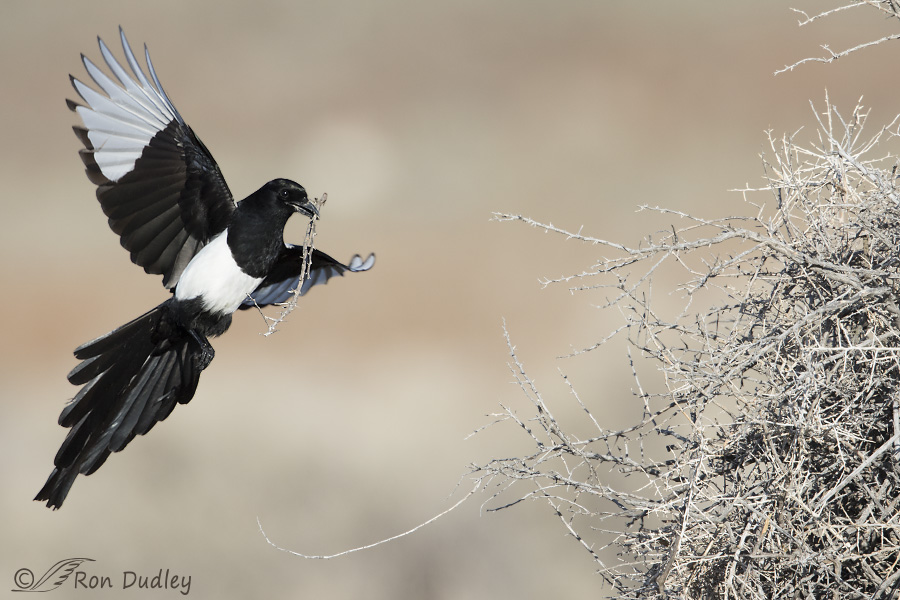
1/2000, f/7.1, ISO 500, Canon 7D Mark II, Canon EF 500mm f/4L IS II USM + 1.4 tc, not baited, set up or called in
Two days ago I photographed this Black-billed Magpie as it carried a twig to its nest on Antelope Island. This time instead of following the bird in with my lens I prefocused on the left side of the nest and waited for the bird to appear in my viewfinder. As a result the nest is slightly sharper than the bird because the magpie isn’t in quite the same plane. The image is full frame (uncropped).
Magpie nests are dome-shaped structures with a nest chamber in the interior and they’re made out of a jumble of sticks and twigs that can make landing on them a tricky maneuver. One threat is eye damage from all the pointed sticks so immediately after touchdown (they do need to see where they’re landing) they often have their nictitating membranes closed to protect their eyes. I delete a lot of otherwise nice images because of that prominently closed membrane.
Magpies line the interior chamber of their nest with mud which explains the mud on the base of this bird’s bill.
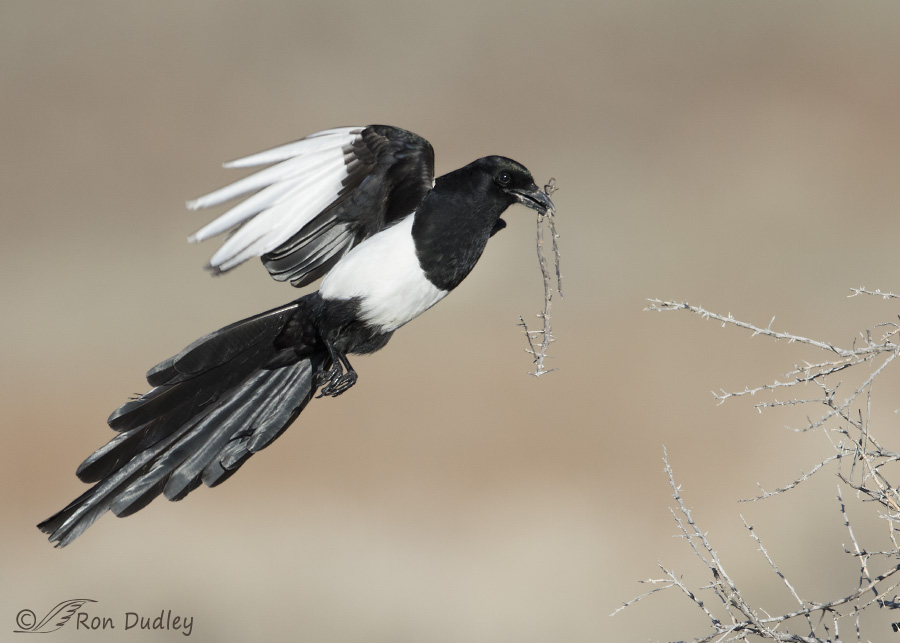
1/2000, f/7.1, ISO 500, Canon 7D Mark II, Canon EF 500mm f/4L IS II USM + 1.4 tc, not baited, set up or called in
The magpie approached the nest a little slower than usual because its intended landing spot…
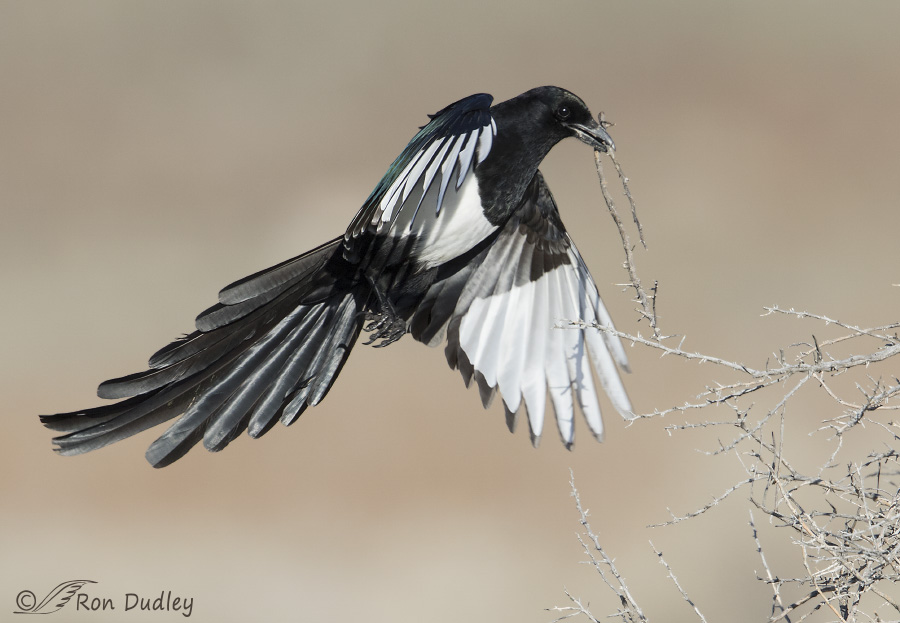
1/2000, f/7.1, ISO 500, Canon 7D Mark II, Canon EF 500mm f/4L IS II USM + 1.4 tc, not baited, set up or called in
was between the long horizontal twig in front of its left wing…
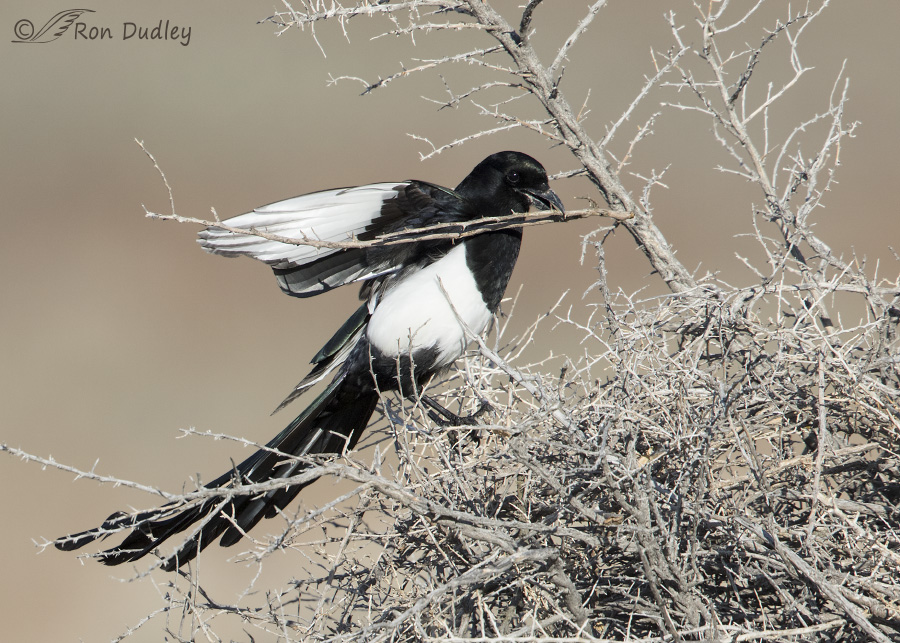
1/2500, f/7.1, ISO 500, Canon 7D Mark II, Canon EF 500mm f/4L IS II USM + 1.4 tc, not baited, set up or called in
and an extremely spikey live branch (the one above its head) coming out of the bush that supports the nest. When it first landed here its right wing was entangled in the twig it was carrying – here it had just lifted that wing away from the twig. This image, with the long horizontal twig at bottom (going out of frame at left) and the spikey branch of the supporting bush above its head, shows just how challenging this landing spot was. Throw in the long, awkward twig the magpie was carrying and the room needed for flapping wings and one has to be impressed with the landing maneuver.
Now the really hard part starts – a choice must be made about where to place the twig so that it supports the structure and shape of the nest. These birds are really picky about that choice.
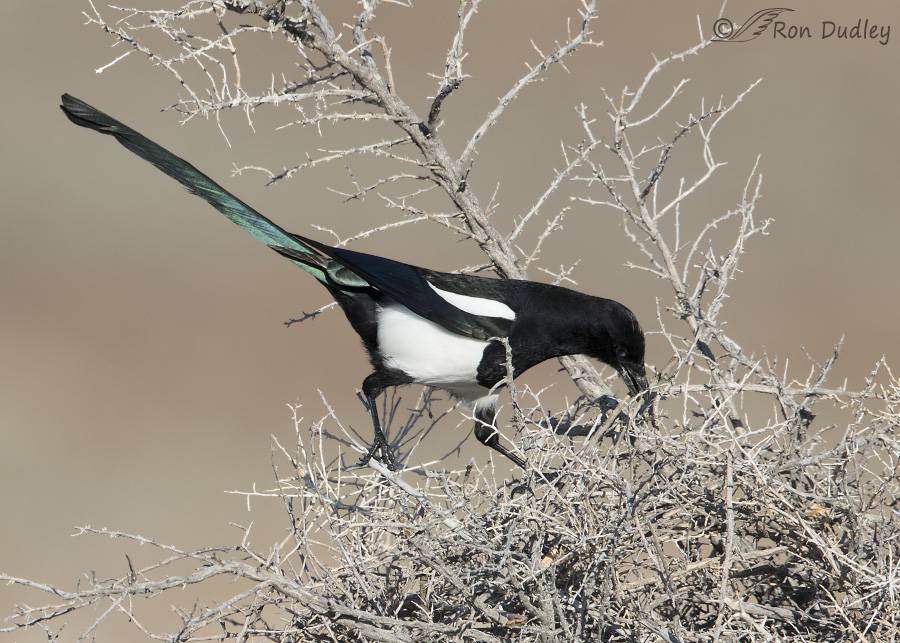
1/2000, f/7.1, ISO 500, Canon 7D Mark II, Canon EF 500mm f/4L IS II USM + 1.4 tc, not baited, set up or called in
At first the magpie tried to place the twig at the base of the supporting branch of the bush but after wiggling and jiggling it into place for a while it changed its mind and…
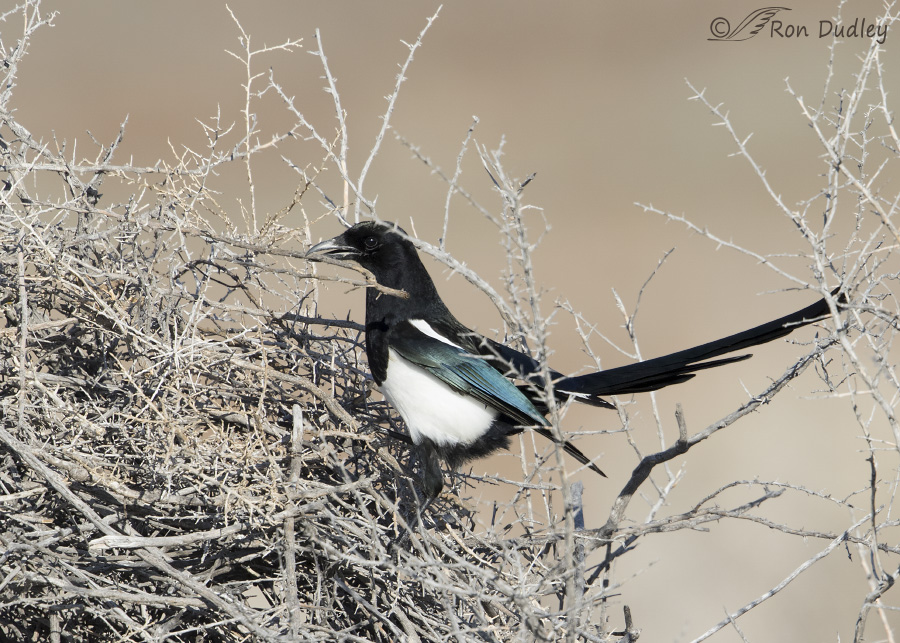
1/1600, f/7.1, ISO 500, Canon 7D Mark II, Canon EF 500mm f/4L IS II USM + 1.4 tc, not baited, set up or called in
carried the twig to the opposite side of the domed nest for possible placement there. But the far side of the twig became entangled in other twigs on the nest and this bird…
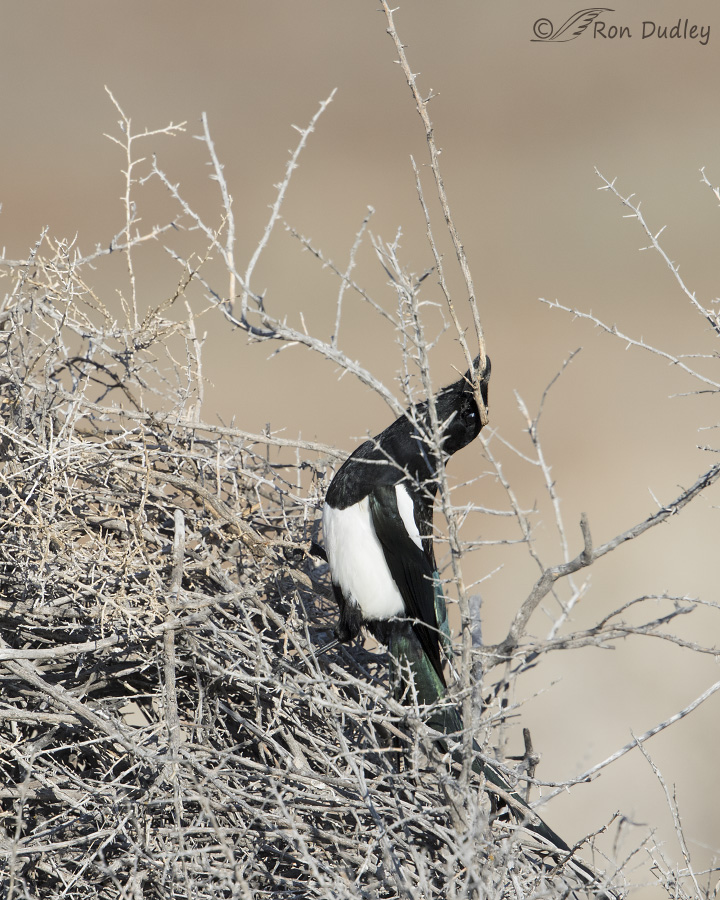
1/1600, f/7.1, ISO 500, Canon 7D Mark II, Canon EF 500mm f/4L IS II USM + 1.4 tc, not baited, set up or called in
really struggled to place the twig in its intended spot. In order to get the far end of the twig out of its entanglement it had to raise it vertically but even this wasn’t far enough so…
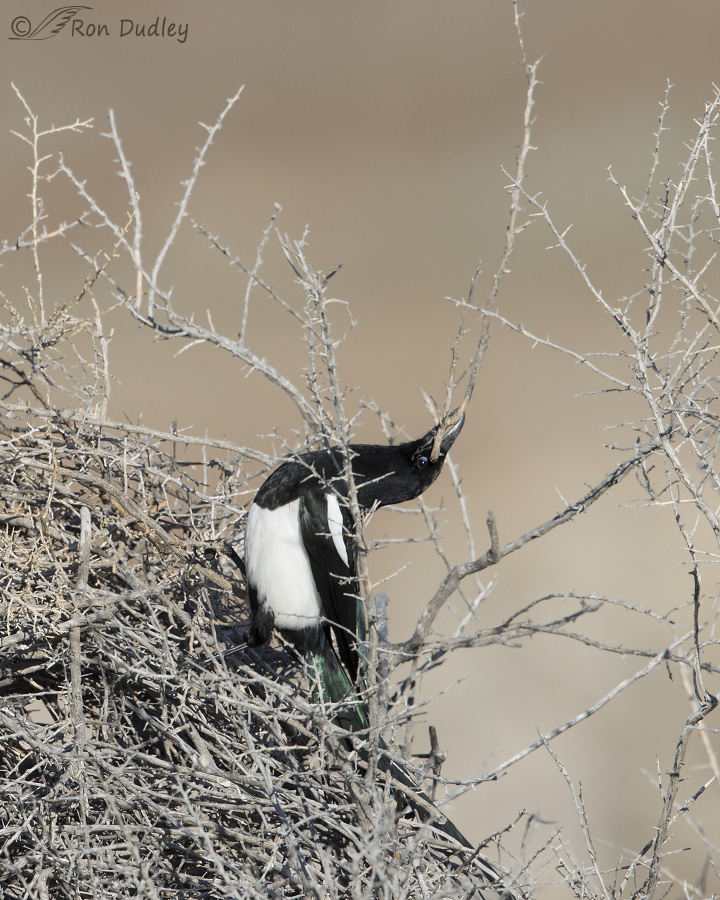
1/2000, f/7.1, ISO 500, Canon 7D Mark II, Canon EF 500mm f/4L IS II USM + 1.4 tc, not baited, set up or called in
it raised the twig past vertical and assumed this comical posture as it did so.
But in the end all this effort was for naught because the awkward twig just wouldn’t go where the magpie wanted it to so the bird eventually placed the twig on the far side of the nest where I didn’t have a very clear view of the proceedings.
The industriousness and skill of birds building nests impresses me enough that I could watch if for hours. And sometimes I do.
Ron
Note: I’m always extremely careful that I’m not disturbing birds near a nest. I always shoot from my pickup on a road and since I’m shooting at an effective 1120mm I’m never close to the nest. These birds have not yet laid eggs.


Amazing behavioral shots Ron, thanks for sharing!
Charlotte
Sometimes I scan the pictures first to see if I can tell the story. And I could. What an interesting series!
Beautiful Photos as usual and interesting nest building skills. Yes I have seen magpies with face and eye injuries, never thought about it being twig damage from nesting material. I am spending a fortune on one at the rehab right now with and ugly infection in its face. 2 surgeries and it is still not out of the
“ICU”.
Wish I had had time to read this before driving to Bozeman this morning. Magpies are building a nest in a tree just outside our big window! Currently it is a mess of sticks – some quite large!! They work for a while in the morning, then that’s it for the day! Love your pictures!..They are so close to the house (15 feet or so), that the only way I could photograph them would be through the window! Otherwise, I’m afraid I would scare them off. I was not aware that they lined the interior with mud!!
Love the pics! Magpies are wonderful birds!
Jane, Your comment reminded me of when magpies were nesting in the big elm tree right next to my house. I was still teaching in those days and enjoyed my morning sleep for as long as I could but those magpies typically woke me up about an hour before I wanted to get up and I didn’t appreciate that much.
Nowadays, I wish they were back…
That intro shot is the best magpie image I’ve ever seen.
That’s quite an endorsement, BW. Thank you very much.
The Magpie is a beautiful bird and great thinking skills. I really enjoyed your blog and fab pics! Love the colorful tail. Laughed at the stick held straight up! Linda
That tail grabs me every time, Linda. Thanks.
Architect, builder, engineer, parent and a high-flying contortionist to boot. W.W.W.
Right on all 5 counts, EC.
And on the Wow. Wow. Wow. count as well. So right on six counts. What a start to my day…
Once again, WOW, what a wonderful series of nest-building shots! Yes, I adore corvids and really miss magpies in my life, so getting this window into their everyday world is just spectacular. Again, THANK you for making this happen.
We’ve been watching the Cornell redtail hawks rebuilding their nest, choosing between two alternative sites, then deciding (we think) on the 2014 nest with the starling PEZ dispenser. Watching them pull branches, specific branches mind, then place and weave them into the nest is simply fascinating. From the bottom (these nests are located on athletic light standards with a horizontal grate for mounting the light boxes), you can see how well anchored they are to the base with the extra added bonus of being well-drained when it gets rainy here. Watching them shape the nest cup, digging and wiggling to get it just right, then adding more cushioning materials (shredded bark and grasses along with evergreen branches with the needles, then repeating the process until it’s just right, oh my how captivating it is for me.
Soon, the nursery will be ready–well mostly because they continue nest building until fledge). As soon as it meets Big Red’s high standards, the first, second and third eggs will arrive (assuming they follow the past four years). Then the Zen of Incubation will begin. Oh how I love the renewal of nesting season!
Again, thank you!
I agree, Laura, it’s a fascinating process to watch, no matter the species.
It’s almost as interesting watching them choose the sticks on the ground (or wherever they get them). They’re picky about which ones they choose. Magpies sometimes dismantle old nests and reuse those sticks and twigs in the nest they’re working on. I see that happen often.
Just a wonderful series of images and commentary–it never occurred to me that there would ever be some wasted effort in building a nest……it’s a creative act
in its essence, and I identified with it, because few people know how much waste goes into the creation, say, of a painting which appears to have “grown” organically.
Interesting point, Kris. While I’m watching them add sticks to a nest I often wonder what goes through their minds when they’re deciding where to put them.
Ron, do the magpie build onto an old existing nest?
David, they don’t exactly “build onto” old nests but they do refurbish them by adding more sticks and redoing the inner chamber with mud and then a nest lining. Some of the nests on the island have been used by magpies for years.
Great shots as usual Ron. However, help me out here, I’ve always wondered how birds deal with building nests in prickly shrubs. I can understand the protective aspects of it, but how do they prevent injury to themselves and especially their young? Do you ever see injury when photographing these birds in a prickly situation? No pun intended.
Dick, your question got me to thinking. I’ve seen many, many birds with injured eyes over the years but I don’t recall ever seeing a magpie with one. I wonder why, given these prickly nests they have to negotiate…
White interesting I just got done cleaning up behind the partial deconstruction of and old nest by the magpies and great horned owls who took it over for a nest – “pick up sticks” in spades!

““pick up sticks” in spades”
Judy, I had a similar experience a few years ago with a magpie nest in a huge elm tree in my yard. What a mess with all those sticks to pick up.
Your comments ate wonderful…next best thing to being there…thanks!!!
I’m glad you enjoyed them, Patty. Thanks.
This is a beautifful, as well as an interesting series. The first shot is especially graceful. I am blown away by the obvious multitude of sticks, all carefully,patiently, skillfully placed to make a nest that complicated and big…a truly amazing feat of engineering!!!
You’re right, Patty. Magpie nests are complex and often massive. This one is actually relatively small but there’s a much larger one nearby.